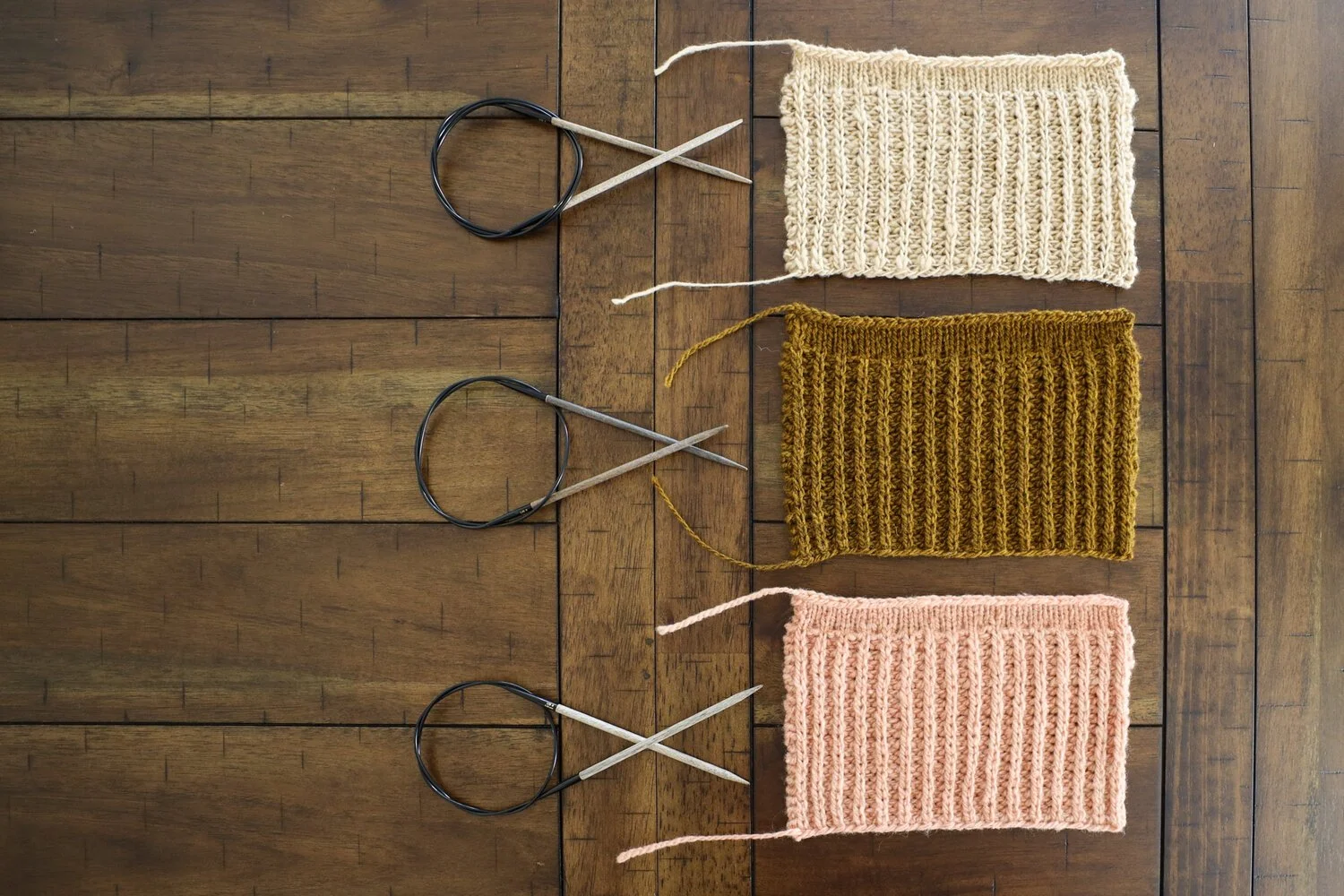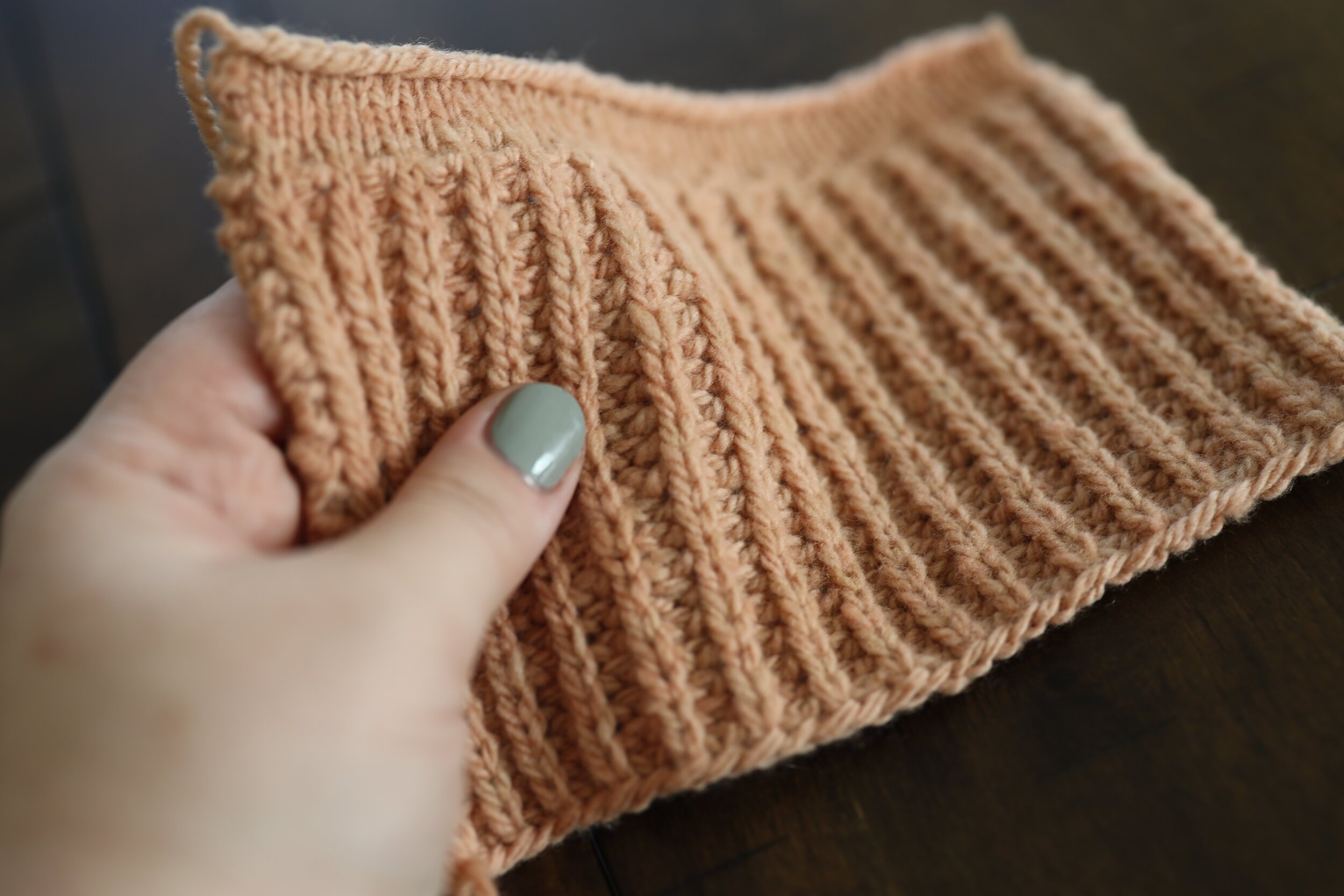Yarn substitution at different weights
One of my favorite things to do as a designer is to reject established “rules” in the knitting world. From assumptions about grading patterns for fat bodies to the received wisdom about what kind of yarn is good for what kind of project, I relish the opportunity to subvert expectations.
Swatches at the same gauge/size in 3 different yarn weights.
Most resources about yarn substitution are geared toward teaching knitters how to find a substitute that is as near a match as possible for the yarn the pattern was originally designed in. This information certainly has its place, especially for newer knitters who are only just beginning to understand the impact of yarn weight and fiber content on a design. But for more experienced knitters, yarn substitution can be a place for creative play with a pattern. What kind of fabric do you want? Is there a way that substituting a different weight/fiber content will alter the pattern to better reflect your vision as a maker?
About yarn weight for Plover/Osprey
Plover and Osprey are two sister patterns both featuring all-over half-brioche stitch (hbs), and they are ideal patterns for playing with yarn weight substitutions. The original pattern, the Plover cardigan, was designed for fingering weight yarn at a very loose gauge, giving the fabric an airy, drapey feel ideal for a light summer layer.
The lightweight fabric in Plover is evident in this gorgeous shot of Brandi Cheyenne Harper from Making No. 9 / SIMPLE.
For the pullover pattern, Osprey, I knit my sample in a sport weight yarn at the exact same gauge, giving the sweater more body and slightly less drape for a more traditional sweater fabric.
The denser fabric in Osprey was achieved with a sport weight yarn.
Both Plover and Osprey would work nicely in anything from fingering through worsted weight yarn, depending on the kind of fabric you want and how you need the sweater to fit into your existing wardrobe. I worked up gauge swatches in each of the 100% Montana Rambouillet bases from The Farmers Daughter Fibers to demonstrate the differences of each at the exact same gauge/size.
Fingering weight
Fingering weight
Yarn: The Farmers Daughter Fibers Soka’pii
Needles: US 6 / 4mm
The fabric is light and airy, when you hold it up it is semi-transparent (as in the photo of Brandi above). It has beautiful drape and the fabric wrinkles easily.
Sport weight
Sport weight
Yarn: The Farmers Daughter Fibers Recollect
Needles: US 5 / 3.75mm
The fabric still has some drape (though not as much as the fingering) and some squish (though not as much as the dk/worsted). It is fully opaque with great stitch definition.
DK/worsted weight
DK/worsted weight
Yarn: The Farmers Daughter Fibers Pishkun
Needles: US 4 / 3.5mm
This is the squishiest, most dense fabric. It doesn’t have much drape but it will make a lovely, bouncy sweater with gorgeous stitch definition.
This video provides a closer look at the qualities of each fabric:
A note on gauge and sizing
To be clear, in this post I am not suggesting that you work with a different yarn weight by modifying the gauge of a pattern and knitting a different size to get it to fit. A modification like this is significantly more complicated and I do not recommend it to knitters who are not prepared to re-grade the pattern (in part or in full) for themselves. Rather, what I am suggesting in this post is that you can knit the pattern exactly as it is written — same gauge, same sizing — but substitute a different yarn weight to get a different kind of fabric.
Things to consider when substituting yarn weights at the same gauge:
Stitch density
Stitch density refers to the distance between stitches in your fabric. Some stitch patterns, like garter stitch or brioche, make naturally bouncier, less dense fabrics than stockinette, so they are ideal candidates for playing around with stitch density. In the photos here, you can see that the lines of knit stitches get closer together as the yarn weight gets heavier in half brioche stitch, but the overall gauge of the fabric remains consistent by changing needle sizes.
Drape
A fabric with denser stitches will have less drape; a fabric with looser stitches will have more drape. Fiber content also plays a role here — a superwash wool will always have more drape than a non-superwash, and fibers like silk or linen will have more drape than wool.
Fabric thickness
This is perhaps the most obvious point, but heavier weight yarns will make for thicker fabrics, so it is worth considering how/when you expect to wear your sweater and whether or prefer something from warmer or cooler weather.
Final word of caution and advice
Whatever you choose for your sweater, be sure to make an extra large gauge swatch before you cast on, just to make sure you are able to achieve the gauge needed to get a sweater that fits how you expect it to! An extra large gauge swatch will also help you determine if you really like the qualities of the fabric for the pattern you are considering.
Happy knitting!!!






